Tags
FORGET EVERYTHING YOU KNOW ABOUT SOIL WHEN GROWING RHODODENDRONS …a must read!
A SHOCKING TITLE BUT I HAD TO GET YOUR ATTENTION
Hopefully this article will cause some commotion and controversy because it goes against much of what is often stated as good advice in books and articles on rhodos and their ***relatives. This info comes from forty years observations “connecting the dots” and experiences in mind …that leads to success with rhodos and their close plant cousins. As some background: I started growing rhodos and their many relatives at the young age of 16, first in NJ, then in Maine, where I formed the Maine Rhodo society many years back. Having grown and sold countless rhodos, watched them in the wild, observed many gardens and nurseries over decades and seeing countless growing methods …well, all that gives this discussion a little weight.
*** First, this article pertains to rhodos and their relatives, that include: Azaleas, Blueberry, Mountain Laurel, Andromeda, Leucothoe, Trailing Arbutus, Wintergreen, Cranberry, Huckleberry, Heaths and Heathers, Oxydendrum …among others.
DON’T FORGET TO READ THE COMMENTS AT THE END …MORE GOOD INFO!
…..Let the commotion begin, with a no holds barred statement of fact:
THE BLACK DIRT SOIL BELOW IS TOXIC & DEADLY TO RHODOS AND THEIR RELATIVES …OVER TIME
I CAN SEE YOU SHAKING YOUR HEAD & THROWING ROTTEN TOMATOES AT ME! At least the tomatoes might like that soil. Aren’t we all told how black, rich dirt and dirt with earthworms is so great for plants. Well, truth is, that’s wrong and deadly over time for rhodos and their many relatives, in spite of what countless books and articles say! Yes Rhodos and their friends need some organic matter, of the right type, but this isn’t it! The right type of organic matter: leaves, semi decayed from oak are the best but there are other good things …read on.
100% BLACK DIRT EQUALS BAD DIRT FOR RHODOS Though the bad effects might not be apparent right away and that is why people often don’t make the right connections when growing rhodos. They may do well for a time in this type of dirt, but then a slow decline can begin. WHY? Before I describe why this soil is bad, further down, I want to make clear, I’m talking where the entire soil structure down to 6 inches or more, is this heavily organic, black dirt. (not naturally peaty, brown, woods soil …that, is generally a good thing.)
WHERE DO RHODOS OCCUR IN NATURE Remember this, rhodos, (and azaleas) in the vast majority of times, do not occur in nature where the soil is like this, so it makes sense (connecting the dots) it’s not their favorite thing to grow in. Many plants are very adaptable to types of soil they can thrive in. That is not the case with rhodos and their relatives. (yet they are not hard if common sense is followed) Generally in nature, rhodos are found in forests with a layer of rotting leaves in the top few inches and then gravelly or loamy soil below, that’s the rule but there are exceptions. They can be found on exposed mountain ridges in very thin soil. Often there might be be clay just 4-5 inches down in the soil layer where they grow naturally. BUT wait! All the references say they don’t like clay. THIS IS ONLY PARTLY TRUE. If the clay is undisturbed and not compacted, they can grow fine in it, if it’s the lower soil layer. For example, in the Smokies there are rhodos and azaleas often in thin soil, that has a clay layer just a few inches down but it’s not compacted. Another example: in central NJ where I grew up, there were countless azalea and blueberries growing in layered soil. That soil was decayed and semi decayed oak leaves in the top 3 to 4 inches, then, generally loose uncompacted clay transitioning below. I recall a dear plant friend at the time, Pam Proctor of Englewood, NJ saying those layers of soil were like a cake. They were and that’s how healthy soil, undisturbed by man should be. Unfortunately most clay soils are hard and compacted from mans use, construction & development …so are not suitable as is. There is plenty of advice on “amending soil” but literally no mention of how healthy soil is layered and transitions as I am describing. Sadly, there really isn’t much info out there that talks about why certain plants die or don’t do well, often just the wrong info is told over and over. Many of the common reasons given don’t tell the whole story. The gardener often thinks its their fault. “I followed all the guidelines I read” they might say and the plant still died, so they might even give up on those plants, thinking they are difficult, when in fact, it was wrong information they used that led to the plants demise.
OK, WHY IS BLACK 100% ORGANIC DIRT BAD FOR RHODOS AND THEIR KIN
1) This black dirt is MUCH MORE PRONE to soil compaction than sandy soil. Soil compaction is a slow killer of rhodos. This is a very important fact. Tread lightly! Just a few “walkings” over the root zone of a rhodo, where soil is like this, does harm. Remember, rhodo roots are very shallow and very delicate, they rip apart easily and do not grow back fast. The hairlike roots of rhodos that take up moisture are incredibly fine and need that well drained, yet semi leafy type soil to thrive …not black dirt. One can easily make this type of good dirt and for less cost and effort than doing the normal but wrong soil prep. Walking over the roots of a rhodo when its loamy or sandy soil is still not good, but not nearly as bad, as that soil does not compress as easily.
2) Rich, black dirt attracts earthworms which are very bad for rhodos …see write up on that below. It is 100% certain earthworms are bad for rhodos though not widely known. If you see them in your soil, pluck them out; find a fisherman friend!
3) It is the wrong texture for rhodo roots. While it might be friable INITIALLY, it does not stay that way. Rhodos after a few years in this totally black dirt, will have shrinking root systems!
4) The ph is often too high
5) 100% black dirt is not typical dirt. Normal dirt has a component of sand, silt, clay and organic matter.
6) Whatever the organic matter is, in this black dirt, as it breaks down it becomes slimy, holds too much water and does not allow air in or conversely, can become resistant to absorbing water when it gets dry…two bad situations. While INITIALLY ok, the long term effect of overly organic soil is deadly.
7) Are you saying “but the soil mix in the pot I bought them in was rich organic soil.” OK… but that was in a nursery setting, with controlled watering, and chemicals possibly to keep diseases in check. The FRESH organic matter in the form of bark, etc. in pots. is great for growing rhodos for the grower, for a short time, until that bark breaks down. But it’s not great for long term results. Sadly, what’s good for the grower may not be good for you the customer. AT EASTERN PLANT our soil mix is part sand, part real dirt from the forest and sometimes perlite (volcanic rock) Our plants see the dirt of the real world, so they can adapt. The analogy is a kid that plays outside in the woods, builds up a better immune system than one that stays in. Rhodos and really any plant grown in real world conditions are MUCH TOUGHER & MORE RESILIENT.
8) If your black dirt is from adding manure that’s another big NO NO. I wont go into why any manure is bad but as the old phrase goes …”just say no to manure” and that’s no BS!
9) When there is this thick, near solid layer of organic matter on top of the existing soil, whatever that soil is, there becomes a huge problem with the “interfacing” of those two layers in that they don’t connect as a whole.
LESSONS LEARNED …A TRUE LIFE EXPERIENCE OF MINE All the above also comes from a personal story and learning experience I had the hard way back in NJ when getting started. I brought in truckloads of compost AND filled the yard with it. Bought tons of rhodos …they did fine for a year then I noticed the root systems were actually getting smaller on the rhodos. Plus, I had to water all the time. Then I saw the earthworm explosion. (didn’t connect those dots yet) Why aren’t my rhodos thriving, no one had the answer. I then began adding and mixing sand into the compost soil. That certainly helped but it still wasn’t right. It took connecting the dots …and years of observations to get the answers. I want to save you that time!
AND OTHERS EXPERIENCES Please read Kathlin Smiths comments below on her real life experience; it perfectly ties in to my comments. (As do the others …all worth reading.)
SOME EXAMPLES OF GOOD RHODO SOIL
THIS SOIL BELOW IS IDEAL FOR RHODOS & RESEMBLES MANY OF THE AREAS THEY GROW IN NATURALLY. THAT MIGHT SURPRISE MANY 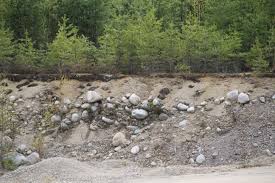
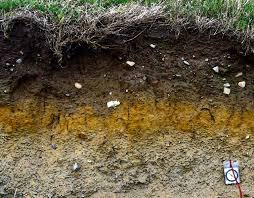
In these two pics we see natural soil layering, which is a healthy soil. In nature, the soil layering and type you see above in these pics, is often the type where rhodos are found in their native habitats …NOT the black dirt pic before it with soil in hand.
Look close at the first pic above….the rock and sandy gravel is obvious but the organic layer in the top 6 inches may not be. So yes, all the references that rhodos need organic matter is TRUE, but it is usually over done, which ultimately can kill them. Picture your self in a forest as above and you are a plant. You do not have a landscaper come each spring or fall and put 4, 5 or 6 inches of compost or bark over your roots …no! Yet what does happen, each year, the leaves from surrounding trees fall …and gently cover the earth and your roots, creating the ideal mulch nature intended. As those leaves or conifer nedles decay, they create a spongy yet airy texture …just the right texture for rhodo type roots to grow in. NOT the pebbly texture worms create.
There are nutrients in the clay type soil that is often 4-6 inches down. Gravel, sand, & rock provide lots of trace minerals often not present in rich, black dirt.
Soil like this, with a sand component will always drain well and over the long term gives great results. Sand, gravelly soil or well drained loam is more vital to rhodo success than organic material …you heard it here!
If you have a natural forest or woods that are undisturbed, they are a good indicator of your soil. Generally, if you have oaks/hickory/beech/conifers, that is a good sign. If you have mostly maples and Ash, that’s generally a bad sign. It doesn’t mean you can’t plant rhodos, just that your native soil might not be ideal. If you have mostly pines/spruces/hemlocks and or mixed with oak, that generally indicates good woodsy soil with that excellent layered soil I am talking about …in many cases all you have to do is dig a shallow hole and plant …no soil fixing needed.
BLACK DIRT INVITES THIS LITTLE GUY! HE IS NOT YOUR FRIEND
FACT: Earthworms are bad for plants in the rhodo family, that includes: Azaleas, Blueberry & Cranberry-Vaccinium, Mountain Laurel-Kalmia, Leucothoe, Trailing Arbutus-Epigea, Wintergreen/Teaberry-Gaultheria, Heaths/Heathers, Sorrel Tree-Oxydendrum …among others.
Earthworms we see are not native to most areas …they were brought from Europe.
See the picture of soil below and its pebbly, crumbly texture. You might think (and books often say) it’s great for all plants, especially rhodos …experts say “its so friable and perfect.” NO and its deadly for rhodos. That pebbly, crumbly texture is from earthworm castings. It ‘might’ be good for tomatoes, lilacs and many other plants but it’s deadly over time for rhodos and their relatives. Add to that, “earthworm soil” tends not to be acid enough for these plants. Step on that earthworm type soil a few times and it becomes compacted muck. Thanks to commenter Deborah Banks for mentioning how earthworms actually destroy the natural leaf litter that is the perfect mulch; see the rest of her comments below.
EARTHWORM TYPE SOIL …BAD FOR RHODOS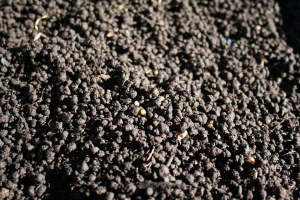
WET SOIL According to all the books, rhodos do not like wet sites and that is generally true…but there ARE EXCEPTIONS if you live in Northern climates. The species maximum (which we grow and have exceptional plants of) CAN tolerate wetter soil in northern climates. One of the reasons for this is that one of the root funguses really cant do well in northern climes as the soil temperature is too low for it. So being up north can have advantages. We have maximum rhodos right on our lake, with roots in water during times of the year. THIS IS NOT recommended though, just an example that R. maximum can tolerate wet sites in cool summer areas.
SOIL AND MULCH The ONLY organic mulches you should use are oak, hickory or beech leaves or pine needles. Gravel can be used as a mulch. Never ever use hardwood bark or chips as mulch …”just say no to hardwood bark as mulch.” Thanks to commenter Dave Delucia for mentioning that Maple leaves should not be used as mulch and why. They mat down, become slimy and do not let air in, they can actually smother small plants too. You can see the rest of his comments below. (all true)
OAK LEAVES ARE NATURES PERFECT MULCH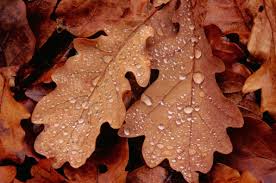
SOIL AND OVER MULCHING SOIL PROBLEMS Over time I have seen countless rhodo gardens go down hill when they were planted in black dirt and or were mulched with bark, too much of it, for many years. This might be totally contradictory to what you have read …but it’s fact. The overmulching fad is one of the biggest scams in horticultural history. All it does is allow incompetent landscape firms to get business …and spread “pretty mulch.” So if you must mulch, don’t over do it.
THE FACT IS I’VE SEEN RHODOS THRIVING WHEN JUST PLANTED INTO PROPER NATIVE SOIL WITH NO AMENDMENTS.
IN CONCLUSION Here at Eastern Plant, 99% of the time when we plant rhodos, we make no soil improvements. We dig a shallow hole, plant, fill in loosely and mulch ONCE with oak leaves or pine needles.THAT’S IT. The rhodos then thrive. I realize many people don’t have the ideal soil we have here, but the important point is not to overdo soil prep and not over mulch and minimize soil compaction by treading lightly around your plants
Eastern Plant, the best rhododendrons in the Eastern U.S. Visit!Grown outside in Maines harsh climate. Tougher, hardier, just better!
Eastern Plant & WildWalkWays Trails …much more than a nursery!
EASTERN PLANT Georgetown, Maine EMAIL easternplant@juno.com MAILORDER AND PICK UP: Rhodos, Ferns, Wildflowers, Natives Landscape Design, Planting & Consultation Tree Work & Forest Management WE TRAVEL! WITH LANDSCAPE CLIENTS THRU ALL NEW ENGLAND

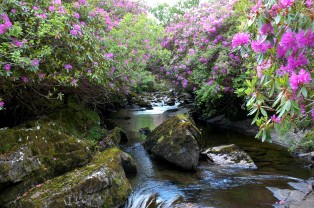


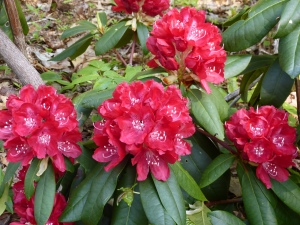
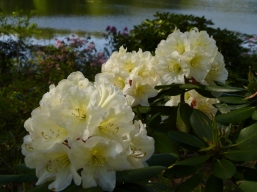
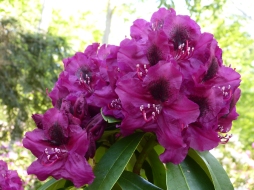
I’ve read in other articles how earthworms are not native to northern forests, and are detrimental because they eat the “duff” normally found on the forest floor. The duff is the leaf and other plant litter that builds up into a thick layer in forests that have no earthworms, providing nutrients and a moist environment for developing an understory of shrubs and young trees. The earthworms consume that duff, mixing it into the upper layers of soil instead. Without the insulating layer of duff, the forest floor is warmer and dryer in the summer, and colder in the winter. All of this is detrimental to the soil organisms, as well as trees and shrubs, that evolved without earthworms. It’s hard to believe at first because we all learned as young gardeners that worms are good for the garden. Turns out they aren’t so good for forests.
LikeLike
Thanks…hopefully we can start a war on earthworms! It’s sad there is so much worng info that keeps getting pushed as truth
LikeLike
Thanks for this excellent blog article, Mark. About the only thing you didn’t emphasize is the detrimental effects of peat moss. Fortunately, the peat moss craze of the 60’s and 70’s is a thing of the past. The other caveat is unraked maple leaves, particularly of the Norway and Sugar Maple. These can get wet very easily and hold way too much moisture, smothering to death smaller plants and rotting low reaching branches of others. Always a pleasure to read your well written pieces….THANK YOU!!
LikeLike
Hi Dave….yes we need to re-educate people on mulching. Perhaps in the future I will do an article on the right and wrong use of peat moss. The other fact is we are destroying our peat bogs for no good reason, as 98% of that peat moss “mined” from bogs across the planet is wasted.
LikeLike
Your article makes sense to me. We live in Maryland, and are fortunate to have a woodland border lot. When we moved to our house 20 years ago, there were a number of rhododendrons (as well as many azaleas and mountain laurels) thriving in what had become a neglected space. When we installed a patio out back, the landscapers added lots of rich soil to the adjacent garden (where there were rhodos). Most of the garden plants did fabulously well, but the rhodos all died within two years.
A few years ago, in an effort to repopulate some of my lost rhodos, I planted one in a garden far from where the previous rhodos had been (I was worried that the rhodos might have died from root fungus, so did not want to replant close to that site). The garden, of course, had amended soil. The rhodo did not thrive; after the first year it started to drop leaves and eventually died.
While we no longer have rhodos on our property, the azaleas and mountain laurels have continued to do fine in their original (non-soil-amended) sites.
I appreciate your comments on mulch–with all of our trees, the gardens get mulched naturally. Saves a lot of work and money!
LikeLike
Hi Kathlin, Yours is a great observation that often, less is more. The take away is: When planting, leave natures soil alone if it’s good. Trying to improve soil often ruins it. All too often supposed landscapers do not know what they are doing; those who claim that title should have to prove they know something about the trade.
LikeLike
These are interesting observations. I would add that it’s essential for all shrubs to have the right mycorrhizae in the soil along with the right PH. The pines/spruces/hemlocks and oak you mention grow well because of their mycorrhizal relationships, and rhodos depend on that too.
LikeLike
Hi Joan, yes the whole mycorrhizae topic is so important and its relationship to plants, especially those in the ericaceous (adid loving) family. Often when I see landscapers or anyone “improving” good forest soil they may be harming the natural mycorrhizae population. It might be a topic for an article in the future.
NOTE for clarification: Mycorrhizae are beneficial fungi that are known to help many many plants, especially those in the ericaceous family. (Rhodos, Laurels, Pieris, blueberry, etc) They are natural in undisturbed healthy forest soil and easily destroyed by “synthetically over improving soil.”
LikeLike
Thanks for your insights! I just learned that here in Northeast Ohio, earthworms were wiped out by the glaciers about 11,000 years ago, so, for practical purposes, they are an invasive species!
You nailed it perfectly with points 4 and 5 — oak leaves, and in my experience, birch leaves as well, tend to acidify soil in a mild, natural way. Soil acidifiers in organic black soil may give the right overall pH, but will surely produce pockets or micro-zones of too much or too little acid,
“Think like a plant” — what great advice! There is nothing to hold onto, to stand up in, with soil that is too loose and friable. I am going to always think like a plant every spring!
LikeLike
Hi Jon, It’s so obvious to me that oak leaves are the perfect mulch. When I see gardens, nearly any garden, mulched with them, that garden is dramatically better than others. There’s a development near here where residents rake away and bag hundreds of bags of oak leaves in fall to be thrown away. Me and my crew go and get them (rescue them!) every year! Glad you see the connection.
LikeLike
I found your article interesting with some surprising facts. Who would have thought that earthworms would be a problems for rhodos? I live in a house that is almost 80 years old and the landscape has rhodos that are at last 60 years old. The are under beech and oak trees so I guess that my rhodos have been lucky to have these natural “ingredients” and not the human added amendments. My rhodos are leggy but they still produce blooms (though not as many as I would like). I have asked experts but they tell me one cannot prune rhodos as old as mine to increase buds. Is that true?
Thank you for this insightful article.
Elizabeth
LikeLike
Hi Elizabeth, yes having oaks is always a good thing. As far as pruning old rhodos, it somewhat depends on the type they are and how leggy they are. Some can be pruned way back and they will sprout near the base; others can’t. In any case, now is not the time; it’s best done in late winter. If you want to send me a pic of them I can maybe give you a better idea. Mark
LikeLike
Yes I agree whole heartedly with this ariticle. I my 40 years of exploring the Southeastern US I have notice the Rhodos evergreen and deciduous both not just growing, but rather thriving in leaf litter with thin sandy soils, often pure loose friable clay and then times rocky crevices. The article is right on point and factual. I find most of what I was taught not just gardening but life in general a bunch of crappy lies or at a minimum untruths. Happy Gardening with Natives.
LikeLike
Hi Jim, yes there is so much wrong info out there on something as basic as gardening. The phrase I use is “connecting the dots’ and it seems so many DON’T do that. I even know of a famous garden near here, where over mulching and supposed soil improvement is ruining some garden plantings and to think “professional” staff were paid to do that harmful work. If i start a gardeners re-education camp here I will have you as one of the coaches.
LikeLike
Great article. I think one factor was overlooked though. I find that organic content, nutrient content, water permeation, and the like are typically addressed. What is not addressed are some of the mineral relationships. Calcium and Magnesium in particular. I have found almost all the forest plants I grow do better if there is some Calcium and Magnesium added. I am curious about your thoughts.
LikeLike
You are absolutely right! In my area inside the Cherokee National Forest rhododendrons thrive in very thin soil which is largely composed of sedimentary rock. They have struggled if they survived long at all when planted NUMEROUS times in “good soil” in my former garden in Atlanta. I had arrived at the same conclusion so I am PLEASED my thoughts are confirmed. Yeah! I’m smarter than I look!!!
LikeLike